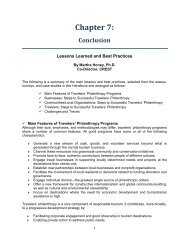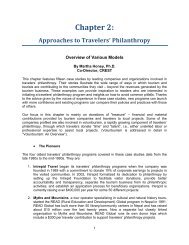Travelers' Philanthropy Handbook - Center for Responsible Travel
Travelers' Philanthropy Handbook - Center for Responsible Travel
Travelers' Philanthropy Handbook - Center for Responsible Travel
Create successful ePaper yourself
Turn your PDF publications into a flip-book with our unique Google optimized e-Paper software.
Can photographs be taken along the way toward completion, to demonstrate to tourists whohave returned home that their money is being spent as intended and to meet the tourists’desire <strong>for</strong> visible evidence of their generosity’s impact? Note in this scenario that potential recipients and handlers of philanthropic funds are actingpreemptively, be<strong>for</strong>e the generous tourist even arrives. Ideally, they will have a feasible,widely accepted, attractive plan of action to suggest in the event that this future touristexpresses a desire to help. What is lost in spontaneity is gained in legitimacy and thelikelihood of project sustainability.On trips where I’ve been the faculty lecturer, we try to build into our itinerary a visit to at leastone local NGO or a meeting with its leaders. In South Africa, our group has visited the violenceprevention programs of the Amy Biehl Foundation. Amy was a student here at Stan<strong>for</strong>d, and Itaught her in her freshman year a course on southern Africa. She was murdered in 1993 at theconclusion of a Fulbright Fellowship in South Africa by young black men in the Cape Towntownship in which she was driving, men who wanted to take revenge on white “settlers” who hadcreated the very system of apartheid Amy was fervently committed to fight. Of course I wasdeeply affected by her murder and by the trans<strong>for</strong>mation of her parents, who did the almostunthinkable thing of <strong>for</strong>giving her killers, going on to establish programs in the townships toreduce violence and create employment <strong>for</strong> young people. In 1997, at the end of a trip downthe African Great Rift Valley, our group worshiped at a Roman Catholic Church in Guguletutownship, close to the site where Amy was killed. Our travelers had seen the best game parksin eastern and southern Africa. But what happened in Saint Gabriel’s Church was, <strong>for</strong> many ofus, by far the most memorable experience of the entire trip. It was incredibly moving <strong>for</strong> us tobe dispersed in twos and threes throughout a black worshipping community that warmlywelcomed us, to hear the sermon preached in three languages, and to join in the rousingsinging of hymns, with teenagers accompanying the congregation on their marimbas. Yes, thelarge game animals we saw in the parks were impressive. But even more so was this humancontact at a deep level, made possible through an organization with strong local roots.It helps if a grassroots organization has been vetted by an outside NGO with a good reputationand has a record of working well with the outside group. On other trips I’ve led I contacted theGlobal Fund <strong>for</strong> Women, a U.S.-based NGO which gives small grants to women’s groupsthroughout the developing world, and the Ashoka Fellows Program, also U.S.-based, whichidentifies social entrepreneurs from developing countries who have initiated impressivedevelopment and social service projects. With their help I identify local organizations in thecountries we will visit. We schedule a visit to the organization’s headquarters and invite itsleader to share a meal with us. While we ask these grassroots organizations not to solicitfunds, <strong>Travel</strong>/Study tour managers make available to our travelers the organizations’ namesand addresses should a traveler choose privately to contribute to their work.Identifying locally legitimate organizations and working with them to fulfill the criteria I’ve listedabove increases the chances that tourist philanthropy will constitute ethical action. Success isnever assured. Indeed, <strong>for</strong> the reasons I’ve given, it is unlikely. But if the chances of successcan be raised a bit through the approach I suggest, the ef<strong>for</strong>t will have been worthwhile. 5858 This chapter is adapted from Dr. Abernethy’s talk to the 1 st International <strong>Travel</strong>ers’ <strong>Philanthropy</strong> Conference organized by CRESTin April, 2004 at Stan<strong>for</strong>d University.190















